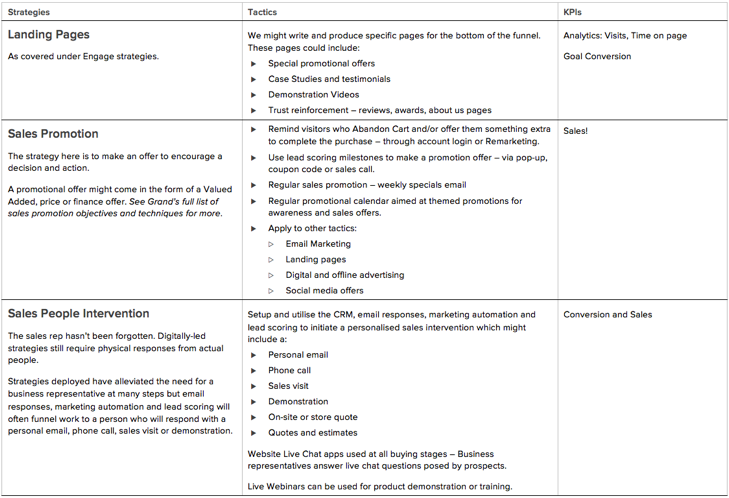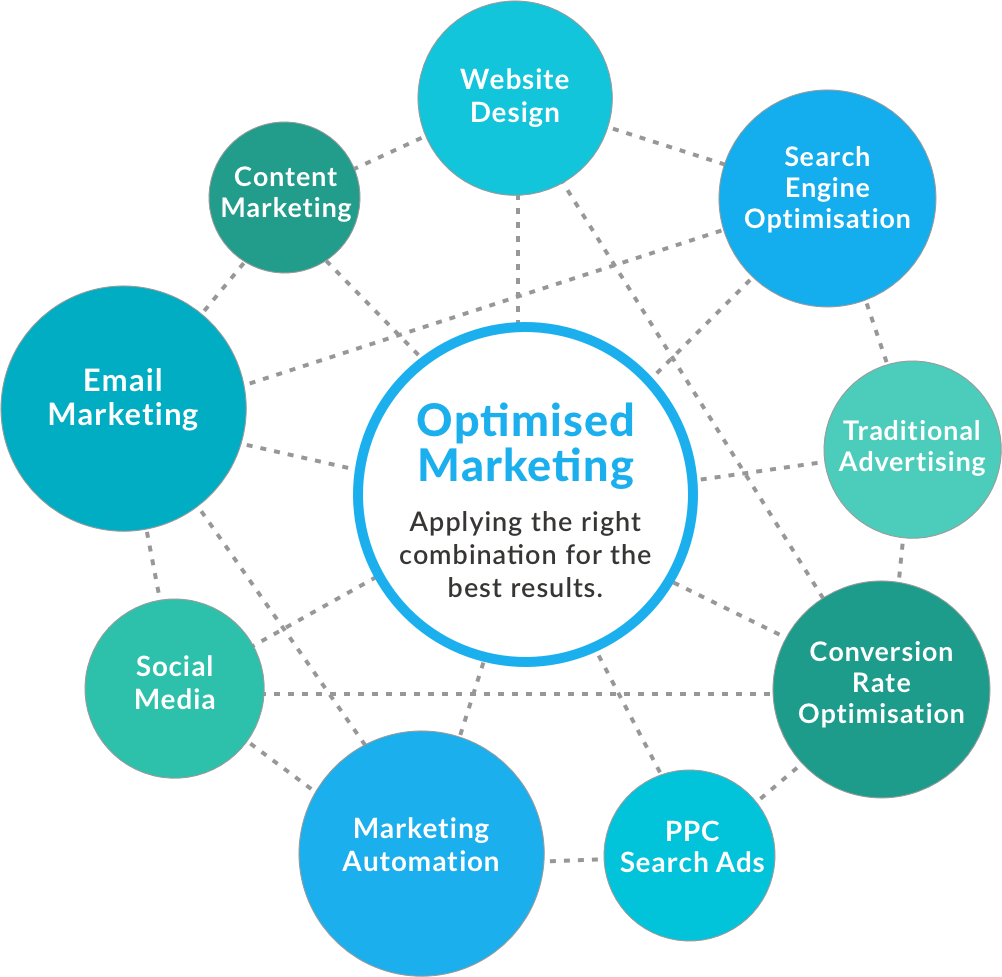The Growth Marketing options available to Marketers are endless, so in this post I’m distilling a long playbook list down to 23 practical tactics that any of our small to medium New Zealand clients can deploy today.
I’ve loosely arranged these example actions into one of three sections. The lines are a little blurred between each section, but you’ll get the picture…
- Website SEO – preparing your most important digital asset.
- Lead Generation – growing traffic and capturing leads.
- Content Marketing – nurturing prospects and closing sales.
A key strength of a Growth Marketing strategy is not hinged on any one campaign, channel, or tactic in particular. The success pivots on each of the channels and actions combining to have an effect that is far greater than the sum of their performance alone.
A strong Growth Marketing plan will take care of short-term wins and develop medium- and long-term successes.
It’s likely to include a mix of our shortlisted tactics: Facebook advertising, Google Ads, display advertising, social media marketing, search engine optimisation, landing page design, conversion rate optimisation, email marketing, content marketing… pretty much anything that will help you achieve your goal.
What’s important with any growth marketing methods, is that you take a fluid approach to budget allocation – adjusting the allocation of your budget each month to the channels where you’re generating the best results. Experiment, test and improve constantly.
Website SEO
I can’t think of many situations where a strong website isn’t the catalyst for better results. So make your website great again.
Firstly, set it up so that it will rank well with Google and get found your prospects.
Then ensure it works hard to convert – changes opinions, captures lead, initiates calls or store visits, or it directly sells something.
Search Engine Optimisation – run a website audit and apply the technical changes for Google’s sake. Apply keyword-researched on-page SEO.
Offsite Link Building – ultimately Google ranks popular sites higher and one of their criteria is the amount of quality backlinks your site has. Here we start by auditing competitor sites to work out what strategies they are using to obtain their ranking for specific keywords and then we’ll look to build a better version of their backlinks.
Website Upgrade – perhaps it’s time for a total upgrade to a state-of-the-art mobile-friendly site that better reflects your brand and its position against your competitors.
Landing Pages – Don’t just send traffic to a general home page; direct it to specific landing pages optimised for certain keyword groups and designed to capture leads or for a specific conversion. Destination URLs from pay-per-click ads should be designed specifically in relation to the keyword or topic which was being advertised. The idea is to make it as easy as possible for the visitor to find the information that is relevant for them. Consider a product like Instapage that also reports on page performance
Conversion Optimisation – construct your landing pages so they encourage a signup or sale. Even subtle changes to button copy can have significant effects. Having the highest conversion rate possible allows you to spend more on marketing than your competitors. Actionable optimisation data could come from Google Analytics, heatmaps, visitor recordings and online surveys.
A/B Split Testing – a fundamental of Growth Marketing is experimentation and testing. Who’s not to say the old clunky page is worse than the new highly-crafted concept page – the only way to find out is to test them side by side at the same time using products like Google Optimise or Optimizely.
Website Trustmarks – An important factor in converting a visitor will always be how much trust they have in your brand or product. If you want a prospect to trust you more, include your clients’ logos, affiliations or employee photos on your website.
Lead Generation
Now that you have new traffic to your website, how can you turn that visitor in to a lead, capture an email address or contact details and then continue to engage and nurture them?
Lead generation is the process of attracting and converting strangers and prospects into someone who has indicated interest in your company’s product or service.
Search Engine Marketing – If you want to attract visitors today then start with paid search advertising (pay-per-click). Our tactics often start with Google Ads for immediate traffic and lead generation.
Facebook Advertising – Conversion focused ads using Remarketing, lookalike Audiences, client website fans and tailored interest groups.
Remarketing – You’ve put effort and money into getting people to your site; now retarget those specific groups of those visitors through Google and Facebook.
Gmail Sponsored Promotions – Here you can even target users receiving emails from your competitors!
YouTube Advertising – Test activity on the next largest search portal after Google search. Consider starting with Veeroll to produce high quality inexpensive video ads.
Pop-ups and Exit Intent – Tastefully styled and intelligently positioned popups can highlight an offer and drive conversion (usually email subscription focused). When all else fails, an Exit Intent popup can catch a visitor before they leave with a special offer or coupon.
Online Chat – Online chat works like text messaging and we all know how popular that is. It’s also inexpensive, so just add it to your site and test out the results.
Email Acquisition – Email can form a valuable core channel for any growth marketing plan but first you need to get those email contacts. Part of the email pool will come from general website lead capture – blog subscribers, quote requests, incomplete signups, purchases or applications and enquiries Valued Content Offers – visitors are only going to give up their email if you offer something valuable to them in return. One way to build your email list is to offer special eBook downloads promoted via Facebook or pay-per-click mediums. Another way could be through competitions; offering a prize to entrants.
Content Marketing & Promotion
Content is the fuel that attracts prospects to your website. Great content engages prospects, warms them to your brand and ultimately helps you build a relationship with customers.
Unfortunately, it’s often an afterthought for businesses. If Google Ads works, why would we need to write a couple of blog articles a month? Why should we let our competitors in on our secret best practice guide? Because great content drives interest in our brand and positions us as a leader in our industry. It shows expertise and builds trust. And it weaponises our personalised emails, monthly newsletters and automated responses, and creates interest in social media, while our banner ads are being ignored.
Blog Articles – Much of our work here will be stimulated through valuable content sort out and searched for by your prospects. We’ll use social media and emails and SEO tactics to attract visitors to your blogs. Even for larger clients, blogging is often a hard tactic to commit to but by using affordable content writers anyone can have a strong blogging presence – which will become a strong foundation for much of our Growth Marketing. Mix your topics up a little; think case studies, reviews, in-depth articles, lists, aggregating other sites’ content.
Blog Optimisation – Your blog pages need to be optimised for lead capture – think popups and inline forms and download offers. Don’t forget to AB Test these as well.
Reviews & Ratings – Use a system to gather reviews and ratings from customers; display them on your site and ensure they are added to Google My Business or aggregated by a 3rd party so that they appear in search and Google Ads results – that way prospects are more likely to click on you.
Email Marketing – Email remains one of the most effective means of delivering personalised messages to prospects and customers. We use it at all stages of the sales funnel, segmenting lists and delivering emails to welcome new subscribers, send requested content, to make special offers, send out periodic product news or bring back a lapsed customer.
Marketing Automation – not so much a strategy as a tool, but one that helps us do more, automating many processes through the funnel; from lead generation, segmenting and tagging users, personalising website pages, controlling email marketing and assisting with CRM.
Loyalty Programme – it seems that Retention Marketing often gets left off the list. Marketing to current or previous customers can take a lot less effort and deliver better returns than finding new ones. A loyalty rewards programme could be just the edge your customers need to come back to you for more. Reviews and ratings – People trust reviews to inform them about their decisions, and reviews play a huge role in people’s purchasing decisions. So set up a system where you ask for them, display them schematically correctly on your website and have them pushed to Google My Business and beyond.


